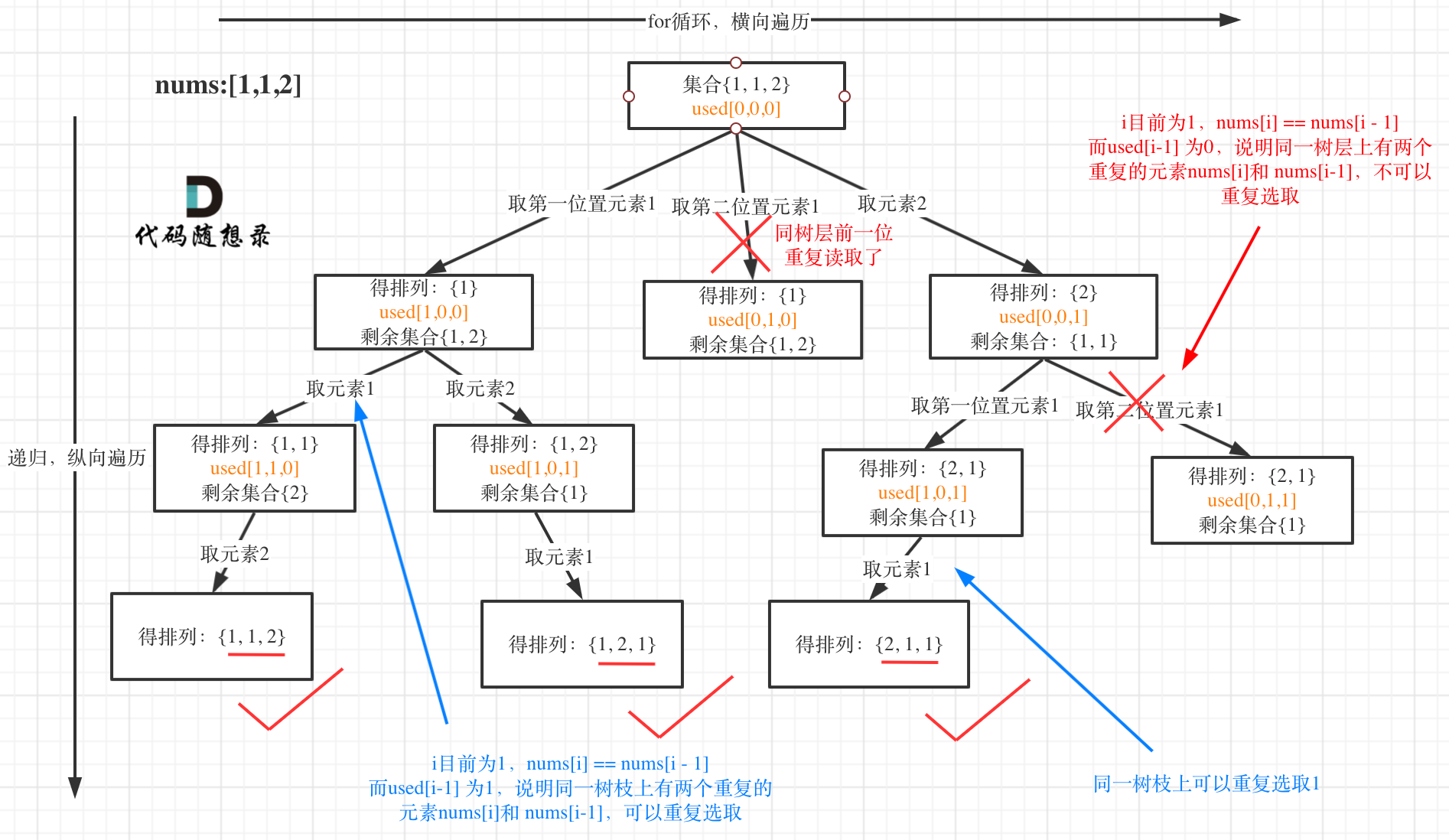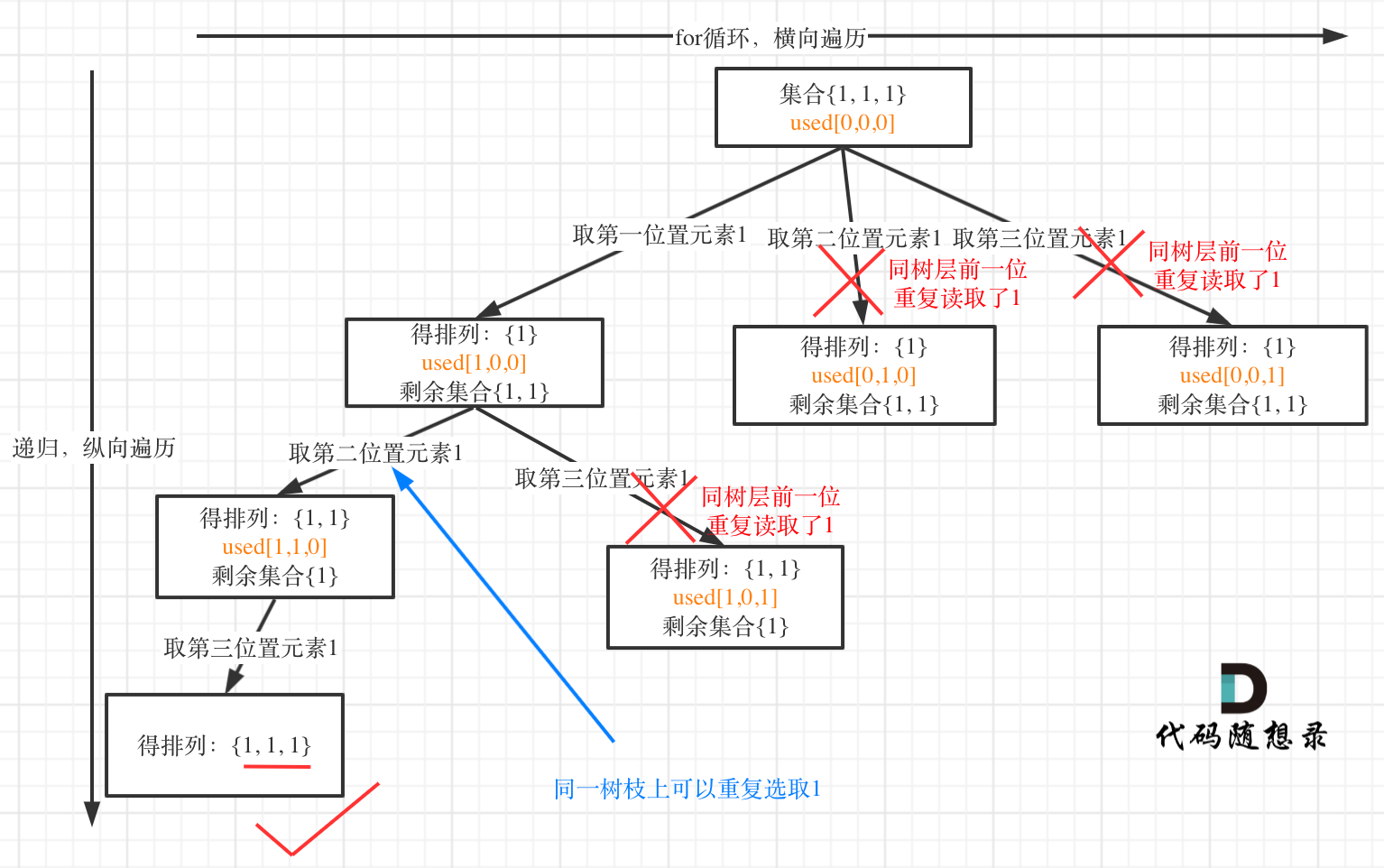- 做项目(多个C++、Java、Go、测开、前端项目) (opens new window)
- 刷算法(两个月高强度学算法) (opens new window)
- 背八股(40天挑战高频面试题) (opens new window)
# 47.全排列 II
给定一个可包含重复数字的序列 nums ,按任意顺序 返回所有不重复的全排列。
示例 1:
- 输入:nums = [1,1,2]
- 输出: [[1,1,2], [1,2,1], [2,1,1]]
示例 2:
- 输入:nums = [1,2,3]
- 输出:[[1,2,3],[1,3,2],[2,1,3],[2,3,1],[3,1,2],[3,2,1]]
提示:
- 1 <= nums.length <= 8
- -10 <= nums[i] <= 10
# 算法公开课
《代码随想录》算法视频公开课 (opens new window):回溯算法求解全排列,如何去重?| LeetCode:47.全排列 II (opens new window),相信结合视频再看本篇题解,更有助于大家对本题的理解。
# 思路
这道题目和46.全排列 (opens new window)的区别在与给定一个可包含重复数字的序列,要返回所有不重复的全排列。
这里又涉及到去重了。
在40.组合总和II (opens new window) 、90.子集II (opens new window)我们分别详细讲解了组合问题和子集问题如何去重。
那么排列问题其实也是一样的套路。
还要强调的是去重一定要对元素进行排序,这样我们才方便通过相邻的节点来判断是否重复使用了。
我以示例中的 [1,1,2]为例 (为了方便举例,已经排序)抽象为一棵树,去重过程如图:

图中我们对同一树层,前一位(也就是nums[i-1])如果使用过,那么就进行去重。
一般来说:组合问题和排列问题是在树形结构的叶子节点上收集结果,而子集问题就是取树上所有节点的结果。
在46.全排列 (opens new window)中已经详细讲解了排列问题的写法,在40.组合总和II (opens new window) 、90.子集II (opens new window)中详细讲解了去重的写法,所以这次我就不用回溯三部曲分析了,直接给出代码,如下:
class Solution {
private:
vector<vector<int>> result;
vector<int> path;
void backtracking (vector<int>& nums, vector<bool>& used) {
// 此时说明找到了一组
if (path.size() == nums.size()) {
result.push_back(path);
return;
}
for (int i = 0; i < nums.size(); i++) {
// used[i - 1] == true,说明同一树枝nums[i - 1]使用过
// used[i - 1] == false,说明同一树层nums[i - 1]使用过
// 如果同一树层nums[i - 1]使用过则直接跳过
if (i > 0 && nums[i] == nums[i - 1] && used[i - 1] == false) {
continue;
}
if (used[i] == false) {
used[i] = true;
path.push_back(nums[i]);
backtracking(nums, used);
path.pop_back();
used[i] = false;
}
}
}
public:
vector<vector<int>> permuteUnique(vector<int>& nums) {
result.clear();
path.clear();
sort(nums.begin(), nums.end()); // 排序
vector<bool> used(nums.size(), false);
backtracking(nums, used);
return result;
}
};
// 时间复杂度: 最差情况所有元素都是唯一的。复杂度和全排列1都是 O(n! * n) 对于 n 个元素一共有 n! 中排列方案。而对于每一个答案,我们需要 O(n) 去复制最终放到 result 数组
// 空间复杂度: O(n) 回溯树的深度取决于我们有多少个元素
2
3
4
5
6
7
8
9
10
11
12
13
14
15
16
17
18
19
20
21
22
23
24
25
26
27
28
29
30
31
32
33
34
35
36
37
38
39
- 时间复杂度: O(n! * n)
- 空间复杂度: O(n)
# 拓展
大家发现,去重最为关键的代码为:
if (i > 0 && nums[i] == nums[i - 1] && used[i - 1] == false) {
continue;
}
2
3
如果改成 used[i - 1] == true, 也是正确的!,去重代码如下:
if (i > 0 && nums[i] == nums[i - 1] && used[i - 1] == true) {
continue;
}
2
3
这是为什么呢,就是上面我刚说的,如果要对树层中前一位去重,就用used[i - 1] == false,如果要对树枝前一位去重用used[i - 1] == true。
对于排列问题,树层上去重和树枝上去重,都是可以的,但是树层上去重效率更高!
这么说是不是有点抽象?
来来来,我就用输入: [1,1,1] 来举一个例子。
树层上去重(used[i - 1] == false),的树形结构如下:

树枝上去重(used[i - 1] == true)的树型结构如下:

大家应该很清晰的看到,树层上对前一位去重非常彻底,效率很高,树枝上对前一位去重虽然最后可以得到答案,但是做了很多无用搜索。
# 总结
这道题其实还是用了我们之前讲过的去重思路,但有意思的是,去重的代码中,这么写:
if (i > 0 && nums[i] == nums[i - 1] && used[i - 1] == false) {
continue;
}
2
3
和这么写:
if (i > 0 && nums[i] == nums[i - 1] && used[i - 1] == true) {
continue;
}
2
3
都是可以的,这也是很多同学做这道题目困惑的地方,知道used[i - 1] == false也行而used[i - 1] == true也行,但是就想不明白为啥。
所以我通过举[1,1,1]的例子,把这两个去重的逻辑分别抽象成树形结构,大家可以一目了然:为什么两种写法都可以以及哪一种效率更高!
这里可能大家又有疑惑,既然 used[i - 1] == false也行而used[i - 1] == true也行,那为什么还要写这个条件呢?
直接这样写 不就完事了?
if (i > 0 && nums[i] == nums[i - 1]) {
continue;
}
2
3
其实并不行,一定要加上 used[i - 1] == false或者used[i - 1] == true,因为 used[i - 1] 要一直是 true 或者一直是false 才可以,而不是 一会是true 一会又是false。 所以这个条件要写上。
是不是豁然开朗了!!
# 其他语言版本
# Java
class Solution {
//存放结果
List<List<Integer>> result = new ArrayList<>();
//暂存结果
List<Integer> path = new ArrayList<>();
public List<List<Integer>> permuteUnique(int[] nums) {
boolean[] used = new boolean[nums.length];
Arrays.fill(used, false);
Arrays.sort(nums);
backTrack(nums, used);
return result;
}
private void backTrack(int[] nums, boolean[] used) {
if (path.size() == nums.length) {
result.add(new ArrayList<>(path));
return;
}
for (int i = 0; i < nums.length; i++) {
// used[i - 1] == true,说明同⼀树⽀nums[i - 1]使⽤过
// used[i - 1] == false,说明同⼀树层nums[i - 1]使⽤过
// 如果同⼀树层nums[i - 1]使⽤过则直接跳过
if (i > 0 && nums[i] == nums[i - 1] && used[i - 1] == false) {
continue;
}
//如果同⼀树⽀nums[i]没使⽤过开始处理
if (used[i] == false) {
used[i] = true;//标记同⼀树⽀nums[i]使⽤过,防止同一树枝重复使用
path.add(nums[i]);
backTrack(nums, used);
path.remove(path.size() - 1);//回溯,说明同⼀树层nums[i]使⽤过,防止下一树层重复
used[i] = false;//回溯
}
}
}
}
2
3
4
5
6
7
8
9
10
11
12
13
14
15
16
17
18
19
20
21
22
23
24
25
26
27
28
29
30
31
32
33
34
35
36
37
Python
class Solution:
def permuteUnique(self, nums):
nums.sort() # 排序
result = []
self.backtracking(nums, [], [False] * len(nums), result)
return result
def backtracking(self, nums, path, used, result):
if len(path) == len(nums):
result.append(path[:])
return
for i in range(len(nums)):
if (i > 0 and nums[i] == nums[i - 1] and not used[i - 1]) or used[i]:
continue
used[i] = True
path.append(nums[i])
self.backtracking(nums, path, used, result)
path.pop()
used[i] = False
2
3
4
5
6
7
8
9
10
11
12
13
14
15
16
17
18
19
20
# Go
var (
res [][]int
path []int
st []bool // state的缩写
)
func permuteUnique(nums []int) [][]int {
res, path = make([][]int, 0), make([]int, 0, len(nums))
st = make([]bool, len(nums))
sort.Ints(nums)
dfs(nums, 0)
return res
}
func dfs(nums []int, cur int) {
if cur == len(nums) {
tmp := make([]int, len(path))
copy(tmp, path)
res = append(res, tmp)
}
for i := 0; i < len(nums); i++ {
if i != 0 && nums[i] == nums[i-1] && !st[i-1] { // 去重,用st来判别是深度还是广度
continue
}
if !st[i] {
path = append(path, nums[i])
st[i] = true
dfs(nums, cur + 1)
st[i] = false
path = path[:len(path)-1]
}
}
}
2
3
4
5
6
7
8
9
10
11
12
13
14
15
16
17
18
19
20
21
22
23
24
25
26
27
28
29
30
31
32
# JavaScript
var permuteUnique = function (nums) {
nums.sort((a, b) => {
return a - b
})
let result = []
let path = []
function backtracing( used) {
if (path.length === nums.length) {
result.push([...path])
return
}
for (let i = 0; i < nums.length; i++) {
if (i > 0 && nums[i] === nums[i - 1] && !used[i - 1]) {
continue
}
if (!used[i]) {
used[i] = true
path.push(nums[i])
backtracing(used)
path.pop()
used[i] = false
}
}
}
backtracing([])
return result
};
2
3
4
5
6
7
8
9
10
11
12
13
14
15
16
17
18
19
20
21
22
23
24
25
26
27
28
29
30
31
# TypeScript
function permuteUnique(nums: number[]): number[][] {
nums.sort((a, b) => a - b);
const resArr: number[][] = [];
const usedArr: boolean[] = new Array(nums.length).fill(false);
backTracking(nums, []);
return resArr;
function backTracking(nums: number[], route: number[]): void {
if (route.length === nums.length) {
resArr.push([...route]);
return;
}
for (let i = 0, length = nums.length; i < length; i++) {
if (i > 0 && nums[i] === nums[i - 1] && usedArr[i - 1] === false) continue;
if (usedArr[i] === false) {
route.push(nums[i]);
usedArr[i] = true;
backTracking(nums, route);
usedArr[i] = false;
route.pop();
}
}
}
};
2
3
4
5
6
7
8
9
10
11
12
13
14
15
16
17
18
19
20
21
22
23
# Swift
func permuteUnique(_ nums: [Int]) -> [[Int]] {
let nums = nums.sorted() // 先排序,以方便相邻元素去重
var result = [[Int]]()
var path = [Int]()
var used = [Bool](repeating: false, count: nums.count)
func backtracking() {
if path.count == nums.count {
result.append(path)
return
}
for i in 0 ..< nums.count {
// !used[i - 1]表示同一树层nums[i - 1]使用过,直接跳过,这一步很关键!
if i > 0, nums[i] == nums[i - 1], !used[i - 1] { continue }
if used[i] { continue }
used[i] = true
path.append(nums[i])
backtracking()
// 回溯
path.removeLast()
used[i] = false
}
}
backtracking()
return result
}
2
3
4
5
6
7
8
9
10
11
12
13
14
15
16
17
18
19
20
21
22
23
24
25
26
# Rust
impl Solution {
fn backtracking(result: &mut Vec<Vec<i32>>, path: &mut Vec<i32>, nums: &Vec<i32>, used: &mut Vec<bool>) {
let len = nums.len();
if path.len() == len {
result.push(path.clone());
return;
}
for i in 0..len {
if i > 0 && nums[i] == nums[i - 1] && used[i - 1] == false { continue; }
if used[i] == false {
used[i] = true;
path.push(nums[i]);
Self::backtracking(result, path, nums, used);
path.pop();
used[i] = false;
}
}
}
pub fn permute_unique(nums: Vec<i32>) -> Vec<Vec<i32>> {
let mut result: Vec<Vec<i32>> = Vec::new();
let mut path: Vec<i32> = Vec::new();
let mut used = vec![false; nums.len()];
let mut nums= nums;
nums.sort();
Self::backtracking(&mut result, &mut path, &nums, &mut used);
result
}
}
2
3
4
5
6
7
8
9
10
11
12
13
14
15
16
17
18
19
20
21
22
23
24
25
26
27
28
29
# C
//临时数组
int *path;
//返回数组
int **ans;
int *used;
int pathTop, ansTop;
//拷贝path到ans中
void copyPath() {
int *tempPath = (int*)malloc(sizeof(int) * pathTop);
int i;
for(i = 0; i < pathTop; ++i) {
tempPath[i] = path[i];
}
ans[ansTop++] = tempPath;
}
void backTracking(int* used, int *nums, int numsSize) {
//若path中元素个数等于numsSize,将path拷贝入ans数组中
if(pathTop == numsSize)
copyPath();
int i;
for(i = 0; i < numsSize; i++) {
//若当前元素已被使用
//或前一位元素与当前元素值相同但并未被使用
//则跳过此分支
if(used[i] || (i != 0 && nums[i] == nums[i-1] && used[i-1] == 0))
continue;
//将当前元素的使用情况设为True
used[i] = 1;
path[pathTop++] = nums[i];
backTracking(used, nums, numsSize);
used[i] = 0;
--pathTop;
}
}
int cmp(void* elem1, void* elem2) {
return *((int*)elem1) - *((int*)elem2);
}
int** permuteUnique(int* nums, int numsSize, int* returnSize, int** returnColumnSizes){
//排序数组
qsort(nums, numsSize, sizeof(int), cmp);
//初始化辅助变量
pathTop = ansTop = 0;
path = (int*)malloc(sizeof(int) * numsSize);
ans = (int**)malloc(sizeof(int*) * 1000);
//初始化used辅助数组
used = (int*)malloc(sizeof(int) * numsSize);
int i;
for(i = 0; i < numsSize; i++) {
used[i] = 0;
}
backTracking(used, nums, numsSize);
//设置返回的数组的长度
*returnSize = ansTop;
*returnColumnSizes = (int*)malloc(sizeof(int) * ansTop);
int z;
for(z = 0; z < ansTop; z++) {
(*returnColumnSizes)[z] = numsSize;
}
return ans;
}
2
3
4
5
6
7
8
9
10
11
12
13
14
15
16
17
18
19
20
21
22
23
24
25
26
27
28
29
30
31
32
33
34
35
36
37
38
39
40
41
42
43
44
45
46
47
48
49
50
51
52
53
54
55
56
57
58
59
60
61
62
63
64
65
66
67
# Scala
object Solution {
import scala.collection.mutable
def permuteUnique(nums: Array[Int]): List[List[Int]] = {
var result = mutable.ListBuffer[List[Int]]()
var path = mutable.ListBuffer[Int]()
var num = nums.sorted // 首先对数据进行排序
def backtracking(used: Array[Boolean]): Unit = {
if (path.size == num.size) {
// 如果path的size等于num了,那么可以添加到结果集
result.append(path.toList)
return
}
// 循环守卫,当前元素没被使用过就进入循环体
for (i <- num.indices if used(i) == false) {
// 当前索引为0,不存在和前一个数字相等可以进入回溯
// 当前索引值和上一个索引不相等,可以回溯
// 前一个索引对应的值没有被选,可以回溯
// 因为Scala没有continue,只能将逻辑反过来写
if (i == 0 || (i > 0 && num(i) != num(i - 1)) || used(i-1) == false) {
used(i) = true
path.append(num(i))
backtracking(used)
path.remove(path.size - 1)
used(i) = false
}
}
}
backtracking(new Array[Boolean](nums.length))
result.toList
}
}
2
3
4
5
6
7
8
9
10
11
12
13
14
15
16
17
18
19
20
21
22
23
24
25
26
27
28
29
30
31
32
33
# C#
public class Solution
{
public List<IList<int>> res = new List<IList<int>>();
public List<int> path = new List<int>();
public IList<IList<int>> PermuteUnique(int[] nums)
{
Array.Sort(nums);
BackTracking(nums, new bool[nums.Length]);
return res;
}
public void BackTracking(int[] nums, bool[] used)
{
if (nums.Length == path.Count)
{
res.Add(new List<int>(path));
return;
}
for (int i = 0; i < nums.Length; i++)
{
if (i > 0 && nums[i] == nums[i - 1] && used[i - 1] == false) continue;
if (used[i]) continue;
path.Add(nums[i]);
used[i] = true;
BackTracking(nums, used);
path.RemoveAt(path.Count - 1);
used[i] = false;
}
}
}
2
3
4
5
6
7
8
9
10
11
12
13
14
15
16
17
18
19
20
21
22
23
24
25
26
27
28
29
← 15. 全排列 17. 回溯周末总结 →
